Hamsters
How Hamsters Can Safely Eat Coconut: A Guide
Get ready to learn how hamsters can enjoy coconut safely and discover essential tips for their well-being.

When it comes to feeding hamsters coconut, it is crucial to provide fresh coconut flesh without the shell in moderation due to its high-fat content. Fresh coconut offers higher nutritional value, while dried coconut flakes should be given sparingly. Remember to remove the coconut shell before feeding and make sure it is fresh and free from additives for the best hamster health.
Keep an eye out for allergic reactions, monitor stool consistency, and watch their weight and activity levels. If you want to guarantee your furry friend’s well-being and discover more tips for safely feeding coconut, we have all the information you need.
Key Takeaways
- Offer fresh coconut flesh without the shell for higher nutrition.
- Feed coconut in moderation due to its high fat content.
- Remove coconut shells before feeding to prevent choking hazards.
- Monitor hamsters for allergic reactions or digestive issues.
- Consult a vet if hamsters show signs of discomfort after consuming coconut.
Nutritional Benefits of Coconut for Hamsters
Coconuts offer a variety of essential nutrients important for enhancing the overall health and well-being of hamsters. These furry friends benefit greatly from the nutritional value that coconut provides. Including coconut in their diet can contribute to a balanced diet, promoting healthy digestive systems and supporting their immune system. Hamsters can enjoy the benefits of fresh foods like coconut, which are rich in essential nutrients important for their well-being.
Moreover, the electrolytes present in coconuts aid in hydration, ensuring hamsters maintain proper fluid balance. The healthy dietary fats found in coconut can also promote skin and fur health, keeping them looking and feeling their best. Additionally, the antioxidants in coconut play a significant role in supporting hamsters’ immune systems, safeguarding their overall health.
Incorporating coconut into your hamster’s diet can be a great way to provide them with the necessary nutrients for excellent health and well-being.
Safe Ways to Offer Coconut to Hamsters

When offering coconut to hamsters, it’s important to provide fresh coconut flesh without the shell to avoid any potential choking hazards. Fresh coconut offers a higher nutritional value compared to dried coconut, making it a healthier treat for your hamster.
Because of its high fat content, it’s essential to feed coconut in moderation. Offering a small amount as an occasional treat can prevent constipation and guarantee your hamster enjoys the benefits of the coconut without any adverse effects.
Additionally, avoid giving hamsters coconut shells to guarantee safe consumption. Proper feeding of coconut involves ensuring that it’s fresh, free from any additives, and provided in a way that minimizes any risks.
Portion Control Guidelines for Feeding Coconut
Effective portion control is essential when incorporating coconut into a hamster’s diet to ensure their well-being and nutritional balance. When it comes to feeding coconut to hamsters, it’s vital to offer it in moderation. Adult hamsters can enjoy a small piece of fresh coconut meat, approximately an inch in size, as an occasional treat. Dried coconut flakes, on the other hand, should be given sparingly, with about a teaspoon once or twice a week being sufficient.
It is important to remember that coconut is high in fat, so portion control is vital to prevent any health issues in hamsters. A suitable amount to offer is around 1 gram of coconut per day. Additionally, always remember to remove the coconut shell before feeding it to your hamster to avoid any potential dental problems.
Alternatives to Coconut for Hamster Treats
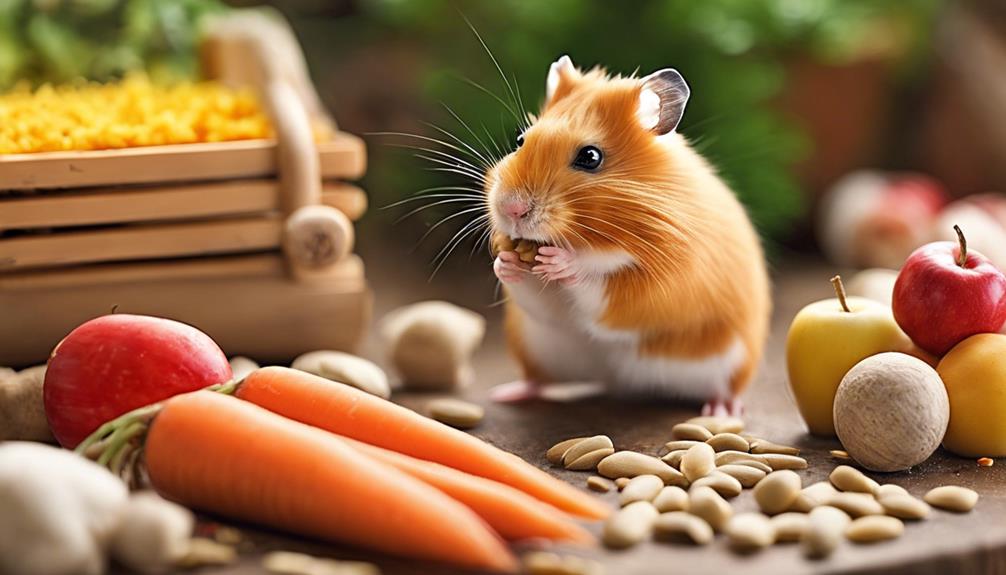
To provide a vital diet for your hamster, exploring alternative treats to coconut can offer a variety of nutritious options. Apples, pears, and berries are excellent fruit choices that can be enjoyed by your pet. These fruits provide essential vitamins and minerals that help keep your hamsters healthy. Additionally, carrots, cucumbers, and bell peppers are low-calorie vegetable options that can be fed in small amounts to aid in digestion and offer variety in their diet.
While coconut can be a tasty snack for your pet, it’s important to remember that commercial hamster food should make up the bulk of their diet, with treats like coconut reserved for occasional indulgences. Opt for fresh fruits and veggies to guarantee a balanced nutrition plan for your furry friend. Remember to avoid sugared or candied coconut products due to their high sugar content, which can be harmful to your pet’s digestive system. Providing a mix of treats won’t only keep your hamster happy but also promote their overall well-being.
What Is Coconut What Is the Nutritiv Content of Coconut
The nutritional content of coconut, specifically the coconut meat or the white flesh inside a coconut, is rich in several nutrients. A cup (80 grams) of fresh, shredded coconut meat contains:
- Calories: 283
- Protein: 3 grams
- Carbs: 10 grams
- Fat: 27 grams
- Sugar: 5 grams
- Fiber: 7 grams
- Manganese: 60% of the Daily Value (DV)
- Selenium: 15% of the DV
- Copper: 44% of the DV
- Phosphorus: 13% of the DV
- Potassium: 6% of the DV
- Iron: 11% of the DV
- Zinc: 10% of the DV
Coconut meat is exceptionally high in calories, saturated fat, and fiber. It also contains a variety of minerals, including manganese, copper, selenium, phosphorus, potassium, and iron. The fat in coconut meat is notable for being high in medium-chain triglycerides (MCTs), which are absorbed intact in the small intestine and used by the human body to produce energy.
Monitoring Hamsters While Eating Coconut

Keeping a close eye on hamsters while they’re eating coconut is essential to guaranteeing their well-being and health. When offering coconut treats to your hamster, watch for any signs of allergic reactions such as itching or swelling. It’s vital to monitor their stool consistency and digestive functions after consuming coconut to detect any adverse effects. Additionally, observe your hamster’s weight and activity levels to make sure that the amount of coconut provided suits their dietary needs.
Pay attention to any reluctance or aversion your hamster may show towards coconut treats, as this could indicate a preference for other foods. Be vigilant for any unusual behaviors or symptoms post-consumption that may suggest a negative reaction to coconut. If your hamster displays any concerning signs, such as decreased appetite or lethargy, consult with a veterinarian promptly. By closely monitoring your hamster’s response to coconut, you can better understand their dietary preferences and secure their overall well-being.
Frequently Asked Questions
Are Coconut Hides Safe for Hamsters?
Indeed, coconut shelters are secure for hamsters. They offer enrichment and nesting possibilities. Verify hides are tidy and devoid of sharp edges. Supervise interactions to avoid mishaps. Coconut shelters are a natural and engaging addition to a hamster’s environment.
Can I Put a Coconut Shell in My Hamster Cage?
Absolutely, we can definitely place a coconut shell in the hamster cage. It’s a fun addition for them to explore and interact with. Just make sure it’s clean, smooth, and regularly checked for safety.
Does Hamster Eat Coconut?
Yes, hamsters can eat coconut. It provides essential nutrients like fiber and healthy fats. Introduce coconut gradually as a treat, making sure it is fresh and shell-free. Monitor for any adverse reactions to guarantee your hamster’s well-being.
Is Coconut Oil Safe for Hamsters Skin?
Yes, coconut oil is safe for hamsters’ skin. It can enhance skin health, give a shiny coat, and has antimicrobial properties. Using high-quality, organic coconut oil without additives is essential. Always consult a vet for safety.
Can Hamsters Eat Both Coconut and Bell Peppers Safely?
Yes, hamsters can eat both coconut and bell peppers safely. However, it’s essential to practice safely feeding hamsters bell peppers in moderation, as too much can upset their stomach. Offer small bits as occasional treats and always remove any uneaten portions to keep their habitat clean.
Conclusion
To sum up, offering coconut as a treat for hamsters can be a delightful and nutritious addition to their diet. By following safe feeding practices and monitoring their consumption, we can guarantee our furry friends enjoy this tropical snack in moderation.
Remember to provide a variety of treats and always prioritize the health and well-being of your hamster.
Happy snacking!
Paul’s love for animals knows no bounds. As a dedicated writer and animal lover, Paul brings a unique perspective to our team. His firsthand experiences with various animals enrich our content and provide valuable insights into their behavior and needs. Whether he’s sharing tips for pet care or shedding light on pressing conservation issues, Paul’s passion for animals shines through in everything he does.
Hamsters
Understanding Ferrets: Do They Bite? Tips & Insight
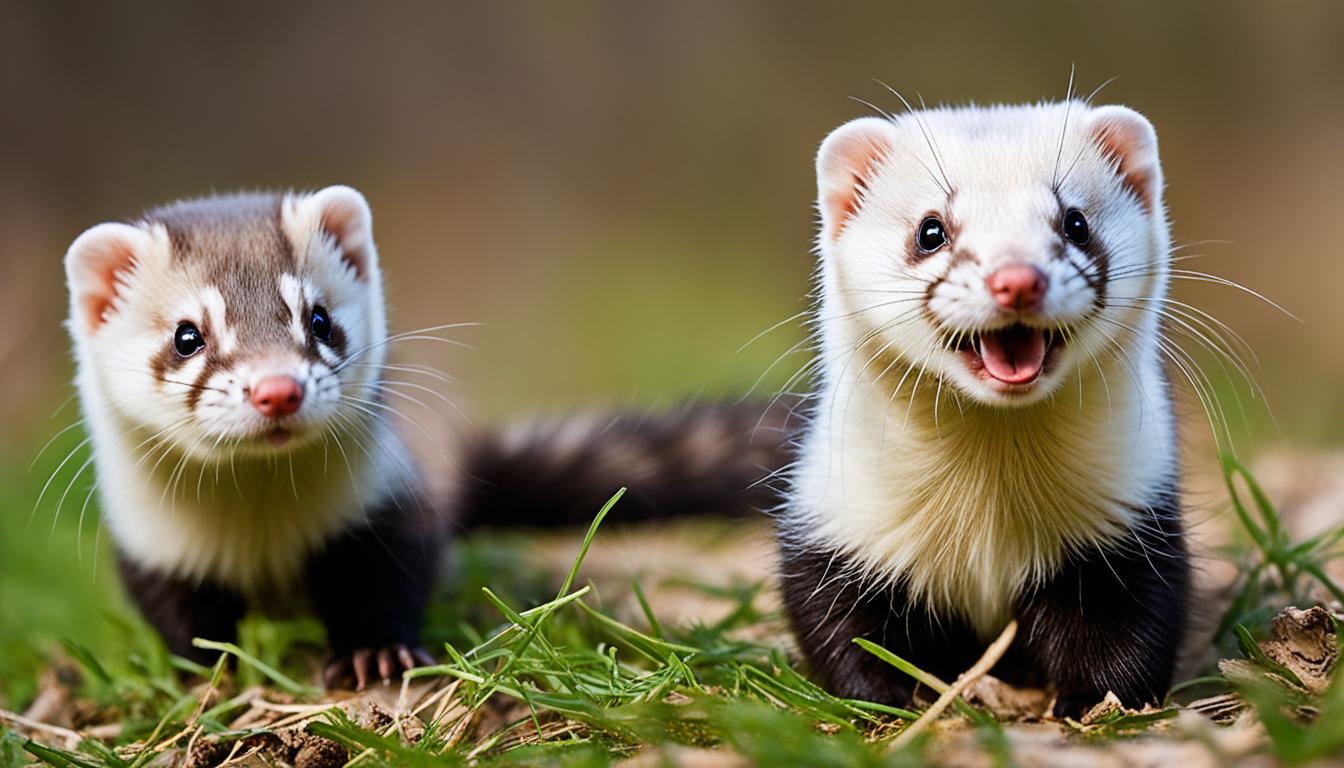
Did you know that ferrets have sharp teeth and a tendency to nibble? Despite their adorable and cuddly exterior, these furry animals can be quite feisty. It may come as a surprise to some that ferrets are capable of biting, causing worries about their suitability as pets. However, fear not! We are here to offer insights into the intriguing realm of ferret behavior and offer helpful advice on how to manage and address biting habits.
Key Takeaways:
- Ferrets may bite for various reasons, such as exploration, teething, fear, dominance, or medical issues.
- Training kits from a young age can help prevent biting behavior and ensure proper socialization.
- Dealing with biting in adult ferrets may require patience, trust-building, and a safe environment.
- Fear biting in ferrets can be addressed through gentle approaches and reward-based training.
- Play biting can be redirected to appropriate toys, and understanding communication signals can prevent biting incidents.
Reasons Why Ferrets Bite
Ferrets are known for their playful and curious nature, but sometimes they might exhibit biting behavior. Understanding the reasons behind ferret biting is crucial for creating a safe and harmonious environment for both the ferret and its human companions. Let’s explore some common reasons why ferrets bite and how to address them effectively.
1. Biting during exploration: Kits, or baby ferrets, often nip as they use their mouths to explore their surroundings. This behavior is natural for them as they are curious about their environment. It is important to redirect their biting behavior towards appropriate toys and discourage them from nipping human skin.
2. Biting due to teething: Just like human babies, ferret kits go through a teething phase, which can cause discomfort. During this period, they might bite more frequently to alleviate teething pain. Providing them with suitable teething toys and frozen treats can help ease their discomfort and prevent them from biting inappropriate objects or people.
3. Biting out of fear: Some ferrets may resort to biting when they feel threatened or fearful. This behavior can be a defense mechanism to protect themselves. Taking a gentle and patient approach when handling fearful ferrets, and gradually exposing them to new experiences can help reduce their fear and minimize biting incidents.
4. Biting to assert dominance: Ferrets are social animals and have a hierarchical nature. In a group setting, they may bite to establish dominance or to communicate their position within the hierarchy. Proper socialization and supervision can help manage these behaviors and prevent aggressive biting.
5. Biting due to medical issues: Ferrets with certain medical conditions, such as dental problems or other sources of pain and discomfort, may resort to biting as a way to express their discomfort. It is important to have regular veterinary check-ups and address any underlying health issues promptly to prevent biting associated with pain.
Ferret Biting Behavior: A Comprehensive Overview
Understanding and addressing ferret biting behavior requires patience, observation, and providing appropriate outlets for natural behaviors. By identifying the underlying cause of biting, whether it’s exploration, teething, fear, dominance, or medical issues, you can take proactive steps to prevent and manage biting incidents. Positive reinforcement, proper handling techniques, and creating a safe and stimulating environment are integral in fostering a harmonious relationship with your ferret.
| Reasons | Description |
|---|---|
| Exploration Biting | Kits may nip during exploration |
| Teething | Kits may bite to alleviate teething discomfort |
| Fear | Ferrets may bite when feeling threatened or fearful |
| Dominance | Ferrets may bite to establish dominance |
| Medical Issues | Biting can be a result of pain or discomfort |

Training Kits to Prevent Biting
When it comes to preventing biting behavior in ferrets, training is key, especially when they are young kits. By starting their training early on, we can effectively discourage biting and set the foundation for a well-behaved and socialized ferret. Patience and consistency are essential during this process. Remember, each kit is unique and will learn at their own pace, so it is important to approach their training with understanding and flexibility.
Socializing kits and teaching them appropriate interaction with humans is a critical component of preventing biting. Introducing them to various environments, people, and experiences helps them become familiar with different stimuli and reduces their likelihood of feeling threatened or fearful. By exposing them to positive, controlled social situations, we can help them develop confidence and minimize aggressive behavior.
Positive reinforcement techniques are particularly effective when training kits to prevent biting. Using rewards such as treats or verbal praise when they display calm and non-biting behavior reinforces the desired actions. This approach encourages them to associate positive experiences with appropriate interactions, further reinforcing good behavior. On the other hand, it is crucial to avoid any form of punishment or aggression during training, as this can escalate fear or anxiety and lead to even more biting.
Sample Training Schedule for Kits
Here is a sample training schedule to help you get started with preventing biting behavior in kits:
- Handle the kit gently and provide a safe, comfortable environment for interaction.
- Introduce the kit to new sights, sounds, and smells gradually, ensuring they feel secure.
- Offer treats and praise when the kit displays calm and non-biting behavior.
- Redirect their attention to appropriate toys or objects when they show signs of wanting to bite.
- Consistently reinforce positive behaviors and discourage biting by immediately removing attention or redirecting focus when they exhibit biting behavior.
- Practice regular socialization with supervised playdates or visits to other ferret-friendly homes.
- Continue training and reinforcing positive behavior as the kit grows, adjusting the training techniques based on their progress and individual needs.
Remember, training kits to prevent biting is an ongoing process that requires dedication and patience. By using positive reinforcement, socialization, and consistent training, you can help your kit develop into a well-behaved and gentle ferret.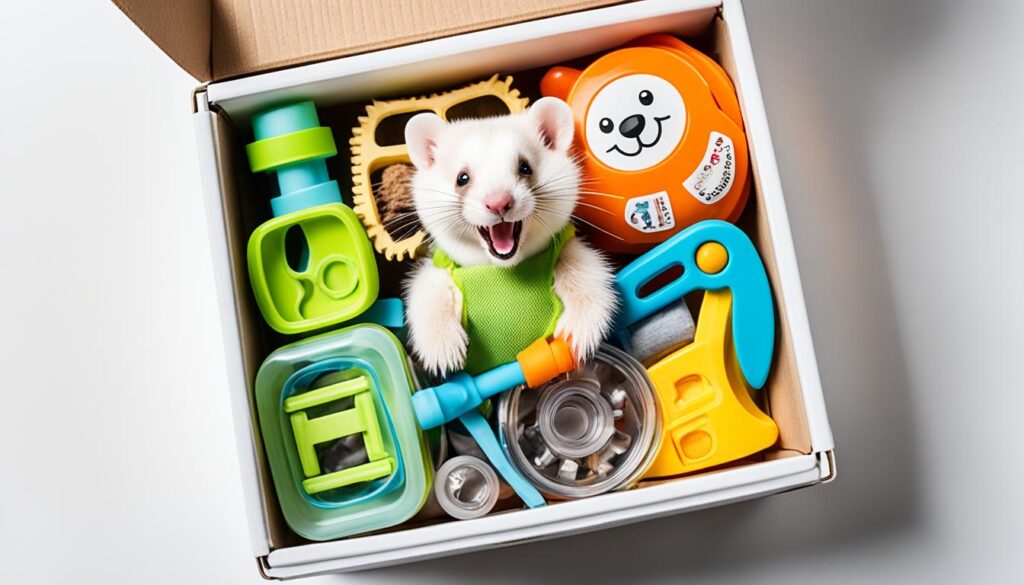
Dealing with Biting in Adult Ferrets
When it comes to adult ferrets displaying biting behavior, it may require more time and effort to address their habits effectively. However, with proper handling, trust-building, and creating a safe environment, you can help prevent biting in adult ferrets.
To address biting in adult ferrets, it is essential to approach the situation with patience, firmness, and gentleness. Remember, ferrets are intelligent creatures that respond well to positive reinforcement techniques.
Proper Handling
One of the key factors in dealing with biting behavior is learning how to handle adult ferrets properly. By supporting their body and minimizing sudden movements or reactions, you can help them feel secure and reduce the likelihood of biting. Gentle and careful handling is crucial to establish trust and prevent fear-based biting.
Building Trust
Building trust with adult ferrets is vital in curbing their biting tendencies. Take the time to spend quality bonding moments with them, such as playing and providing treats. By consistently showing them love, care, and respect, you can foster a stronger bond and minimize biting behavior.
Creating a Safe Environment
Providing a safe and secure environment is essential for adult ferrets. Ensure that their living space is free from potential hazards and stressors that may trigger biting behavior. A well-designed and enriched environment, with plenty of toys and mental stimulation, can also reduce boredom and the likelihood of biting.
Remember, adult ferrets may require additional time and effort to overcome biting habits. With patience, consistency, and a gentle approach, you can work towards minimizing biting behavior in adult ferrets and create a harmonious relationship based on trust and mutual respect.
Fear Biting in Ferrets
Some ferrets may exhibit fear biting due to past traumatic experiences or lack of confidence. Fearful ferret behavior can be challenging to address, but with patience and proper techniques, it is possible to help them overcome their fears.
When dealing with fear biters, it is important to approach them gently and create an environment of trust. Avoid making sudden movements or loud noises that may startle or trigger their fear response.
One effective method to address fear biting is through reward-based training. By using positive reinforcement techniques, such as treats and praise, you can gradually build their confidence and associate positive experiences with human interaction.
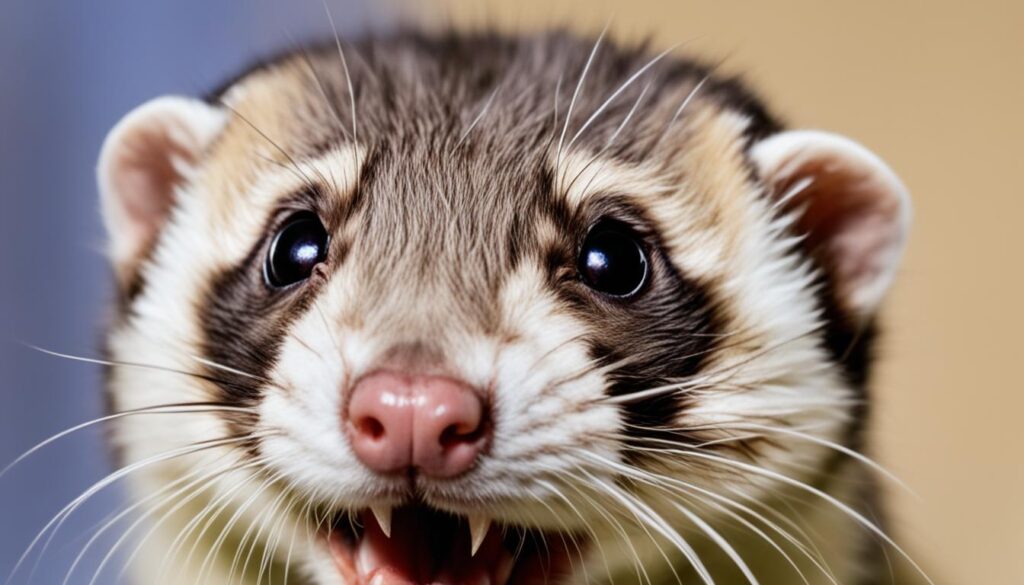
Acclimation techniques can also be helpful in reducing fear biting behavior. Introduce new experiences and environments slowly, allowing the ferret to become familiar and comfortable at their own pace.
To illustrate these approaches, refer to the following table that outlines strategies for addressing fear biting in ferrets:
| Techniques to Address Fear Biting | Benefits |
|---|---|
| 1. Gentle and patient approach | – Builds trust and reduces fear |
| 2. Reward-based training | – Associates positive experiences with human interaction |
| 3. Gradual acclimation to new experiences | – Reduces anxiety and fosters confidence |
By implementing these techniques and providing a supportive environment, ferret owners can help fearful ferrets overcome their fears and reduce fear biting behavior.
Play Biting in Ferrets
Ferrets are known for their playful nature, and play biting is a common behavior exhibited during playtime. When ferrets play, they may occasionally nip or gently bite as a form of interaction. Understanding this behavior is essential for both the ferret’s well-being and the owner’s enjoyment of playtime.
Play biting is different from aggressive biting, which is characterized by a ferret biting with force, aggression, or intention to harm. Play biting, on the other hand, is usually gentle and does not cause harm or pain.
To manage play biting effectively, it is important to establish clear boundaries and redirect the ferret’s biting behavior onto appropriate toys or objects instead of human skin. This can be achieved by providing a variety of interactive toys and engaging in play sessions with the ferret.
“Redirecting the ferret’s biting behavior onto appropriate toys or objects instead of human skin is key to managing play biting effectively.”
When the ferret playfully bites during playtime, it is best to ignore the behavior. Reacting strongly by shouting or pulling away may inadvertently reinforce the behavior, as it provides attention and interaction. Instead, remain calm and still, avoiding any sudden movements that may excite the ferret further. By withholding attention, the ferret learns that biting does not elicit the desired response.
Once the ferret stops biting and exhibits calm behavior, reward them with praise and treats. Positive reinforcement helps to reinforce desirable behavior and can help deter play biting in the long run.
In addition to redirecting and rewarding, it is important to provide ample opportunities for exercise and mental stimulation. Ferrets have high energy levels and need regular play sessions to channel their energy in a positive way. Engaging in interactive play, such as chasing toys or playing hide-and-seek, can help satisfy their instinct to play and reduce play biting tendencies.
“Regular play sessions and ample opportunities for exercise can help reduce play biting tendencies in ferrets.”
Remember, ferrets are social animals, and play is an essential part of their daily routine. By understanding and managing play biting behavior appropriately, we can foster a harmonious and enjoyable playtime experience with our ferret companions.
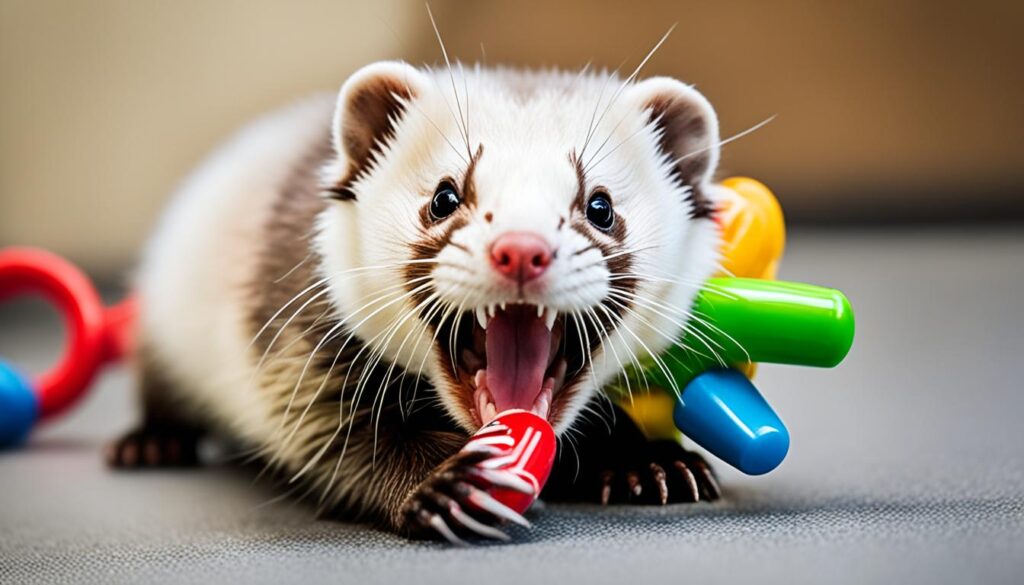
| Tips for Managing Play Biting in Ferrets |
|---|
| Establish clear boundaries and redirect biting onto appropriate toys or objects. |
| Ignore play biting when it occurs, avoiding any strong reactions. |
| Reward calm behavior and provide positive reinforcement. |
| Engage in regular play sessions to satisfy their high energy levels. |
Communication Signals and Biting
Ferrets have a unique way of communication, and sometimes biting is used as a means to convey their messages. However, it’s important to note that biting isn’t the sole form of communication for ferrets. They also exhibit various other signals to express their needs and emotions. By understanding these communication signals and promptly responding to them, you can prevent biting episodes in your ferret and maintain a harmonious bond.
Nuzzling:
One common communication signal that ferrets use is nuzzling. It’s their way of seeking attention or affection from their owners. Nuzzling can be accompanied by chirping noises or gentle paw touches. By recognizing these gestures, you can fulfill your ferret’s need for interaction, reducing the likelihood of biting.
Waiting for Attention:
Ferrets often exhibit patience to get what they want. You may notice your ferret sitting calmly or following you around, waiting for your attention. This is a clear indication that they want to engage with you. By acknowledging their presence and spending quality time together, you can satisfy their need for companionship and decrease the likelihood of biting.
“Understanding and responding to your ferret’s communication signals is crucial in preventing biting incidents. By recognizing the subtle cues they display, such as nuzzling and waiting for attention, you can fulfill their emotional needs and build a strong bond built on trust and understanding.”
It’s important to note that every ferret may have its unique set of communication signals. Observing your ferret’s behavior and being attentive to their needs will help you develop a deeper understanding of their specific signals. By responding appropriately and providing a nurturing environment, you can effectively prevent biting and foster a happy and communicative relationship with your ferret.
When your ferret communicates through behaviors other than biting, it’s crucial to respond promptly and address their needs. By doing so, you establish a clear line of communication and create a bond of trust and understanding.
Next, let’s take a look at some preventive measures you can implement to reduce the likelihood of biting incidents in your ferret.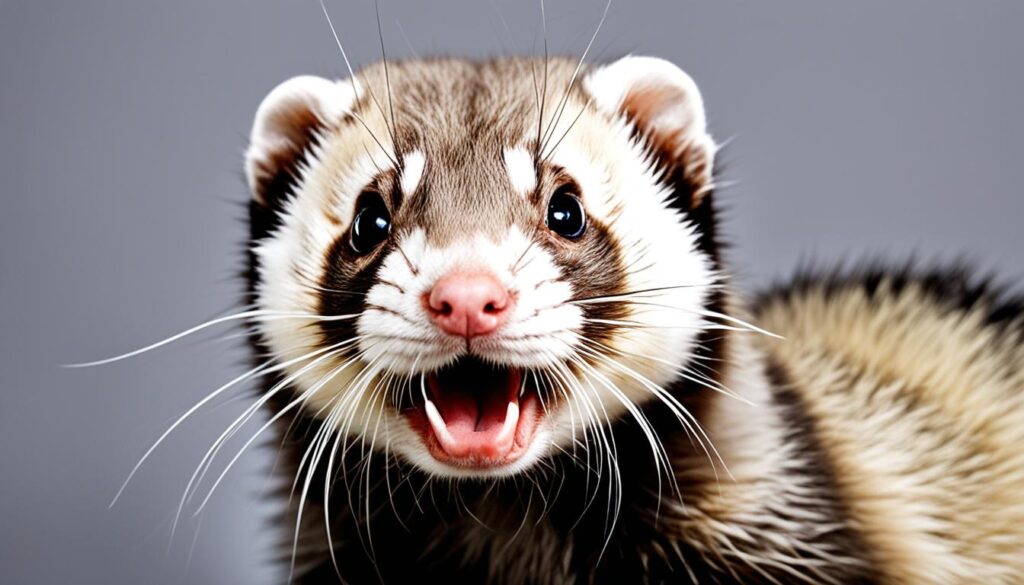
Preventive Measures for Biting
When it comes to preventing biting in ferrets, proactive measures can go a long way in ensuring a safe and harmonious environment. By providing appropriate care and addressing their natural behaviors, you can minimize the likelihood of biting incidents.
1. Enrichment and Toys
Ferrets are active and intelligent animals that require mental and physical stimulation. Providing a variety of toys and outlets for their natural behaviors can help prevent boredom and frustration that may lead to biting. Toys such as tunnels, puzzles, and interactive games can engage their curiosity and keep them entertained for hours.
2. Regular Socialization
Regular socialization is essential for ferrets. Exposing them to different environments, people, and animals from a young age can help them become more comfortable and less likely to bite out of fear or anxiety. Gradual introductions and positive experiences during socialization can build their confidence and reduce aggressive tendencies.
3. A Safe and Stimulating Environment
Creating a safe and stimulating environment is crucial for preventing biting. Ferrets need plenty of space to explore, climb, and play. Ensure their enclosure is secure, free of potential hazards, and offers different levels and hiding spots. Additionally, providing a consistent routine and opportunities for exercise can help alleviate pent-up energy that may trigger biting behavior.
4. Consistent Positive Reinforcement Training
Positive reinforcement training is effective in shaping desirable behavior and discouraging biting. Rewarding good behavior, such as gentle interactions and appropriate play, can reinforce positive habits. Conversely, it is important to avoid punishment or aggression, as it can lead to fear-based biting and damage the ferret-owner relationship.
5. Ferret-Safe Households
Creating a ferret-safe household is crucial for their well-being and preventing biting incidents. Ferret-proofing your home by blocking off small spaces, securing electrical cords, and removing potential hazards can help minimize the risk of accidents or injuries that may trigger defensive biting.
6. Veterinary Care
Maintaining regular veterinary care is essential for ferret health. Regular check-ups can help identify any underlying medical conditions that may cause pain or discomfort, leading to biting behavior. Addressing these health issues promptly can alleviate their discomfort and reduce the likelihood of biting.
| Preventive Measures for Biting | Description |
|---|---|
| Enrichment and Toys | Provide a variety of toys and outlets for natural behaviors. |
| Regular Socialization | Expose ferrets to different environments, people, and animals. |
| A Safe and Stimulating Environment | Create a secure environment with ample space and mental stimulation. |
| Consistent Positive Reinforcement Training | Use positive reinforcement to shape desirable behavior and discourage biting. |
| Ferret-Safe Households | Ferret-proof your home to minimize potential hazards. |
| Veterinary Care | Maintain regular check-ups to address any underlying medical conditions. |
By implementing these preventive measures, you can create a safe and comfortable environment for your ferret, reducing the likelihood of biting. Remember that each ferret is unique, so it’s important to observe their behavior, provide them with appropriate care, and seek professional advice if needed.
Handling Ferrets Safely
Proper handling techniques are vital for ensuring the safety of both ferrets and their handlers. By following these guidelines, you can prevent biting incidents and establish a trusting relationship with your ferret.
When handling a ferret, it’s important to support their body, especially their back end, to help them feel secure. Avoid any sudden movements or reactions as these may startle the ferret and increase the likelihood of biting. Remember, gentle and calm handling is key to building trust.
Here are some tips for safe ferret handling:
- Approach with care: Before picking up a ferret, make sure they are calm and relaxed. Approach them slowly and speak softly to let them know you mean no harm.
- Support their body: When lifting a ferret, place one hand under their chest and the other hand under their hind end. This way, you can provide stability and support to prevent any accidental falls or injuries.
- Avoid restrictive holds: Refrain from squeezing or restraining a ferret tightly. They need freedom of movement to feel comfortable and secure.
- Know their comfort zones: Observe your ferret’s body language and respect their personal space. Some ferrets may not enjoy being held for long periods, while others may feel more relaxed when wrapped in a towel or blanket.
Remember, each ferret is unique, and it’s essential to understand their individual preferences and comfort levels. Taking the time to handle your ferret gently and with care will help to establish a bond based on trust and prevent fear-based biting.
In the words of ferret enthusiast Byron O’Conner:
“Ferrets are incredibly agile and delicate creatures. Handle them with love and respect, and they will reward you with their playful nature and unwavering affection.”
| Handling Tips | Benefits |
|---|---|
| Gently support the ferret’s body | Prevents accidental falls and injuries |
| Avoid sudden movements or reactions | Reduces the likelihood of biting due to fear or stress |
| Respect their personal space | Helps establish trust and a sense of security |
| Observe their comfort zones | Allows for individual preferences and reduces anxiety |
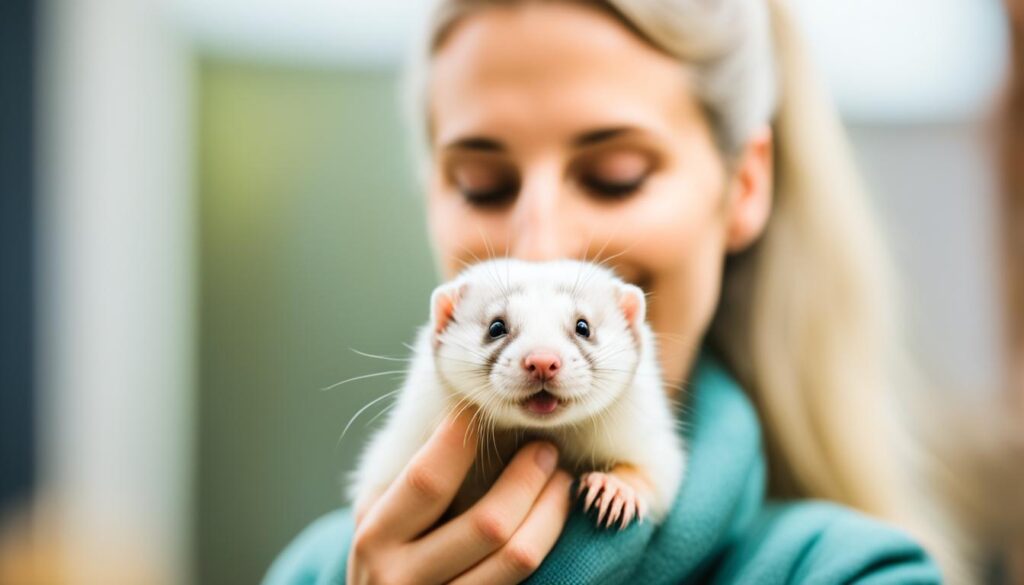
Ferret Behavior: Frolicking and Sleeping Patterns
Understanding ferret behavior is essential for fostering a strong bond with your furry companions. As pet owners, it’s important to navigate their interactions with insight into their unique characteristics. Ferrets are known for their playful frolicking, which is an expression of joy and excitement. Witnessing their energetic leaps and bounds can bring a smile to anyone’s face.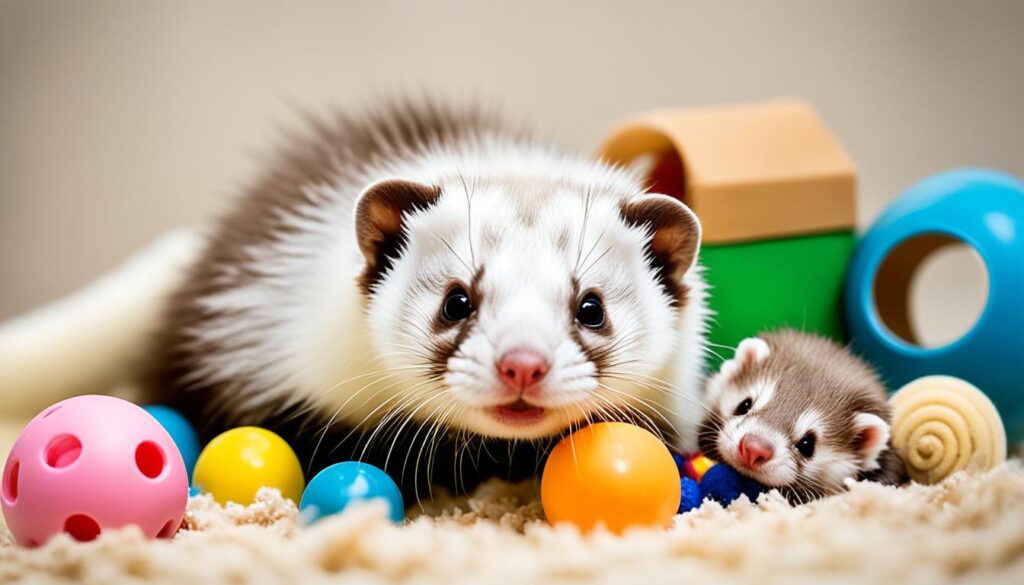
Additionally, ferrets have distinct sleeping patterns that may surprise some pet owners. They often fall into deep, relaxed sleep, which can sometimes be mistaken for unconsciousness. During these resting periods, their bodies become limp, their breathing slows down, and they may even twitch or make small noises. It’s essential to understand and appreciate these natural behaviors to provide appropriate care and support for your ferrets.
Conclusion
Understanding ferrets and preventing biting behavior is crucial for building a strong bond with these playful and affectionate companions. By taking a patient and consistent approach, while considering their natural behaviors, we can create a safe and harmonious environment for our furry friends.
To prevent biting, it is important to address the underlying causes. Whether it’s teething, fear, or communication, identifying the root cause will help us implement the right training techniques. Positive reinforcement training, along with regular socialization and a stimulating environment, can go a long way in preventing biting and creating a trusting relationship.
Proper handling is also a key factor in preventing biting incidents. By gently supporting their bodies and minimizing sudden movements, we can help our ferrets feel secure and reduce the likelihood of fear-based biting. By understanding their unique behaviors, such as frolicking and sleeping patterns, we can provide them with the care they need.
In conclusion, with understanding, patience, and proper training techniques, we can ensure that our ferrets become wonderful companions without excessive biting behavior. By taking these preventive measures, we can create a bond built on trust, respect, and a mutual understanding of each other’s needs.FAQ
Do ferrets bite?
What are the reasons why ferrets bite?
How can I train kits to prevent biting?
How can I deal with biting in adult ferrets?
What should I do about fear biting in ferrets?
How can I prevent play biting in ferrets?
Why do ferrets use biting as a means of communication?
What preventive measures can I take to reduce biting in ferrets?
How can I handle ferrets safely to prevent biting?
What should I know about ferret behavior, such as frolicking and sleeping patterns?
As our Editor-in-Chief, James plays a pivotal role in ensuring the quality and integrity of our content. With a keen eye for detail and a passion for storytelling, James oversees the editorial process here at A Place for Animals. With years of experience in content editing, James ensures that every piece of content meets our high standards of accuracy and clarity. Under James’ guidance, you can rest assured that the content you read is informative and impeccably crafted.
Hamsters
Cat vs Snake: Who Triumphs in a Tussle?

Did you realize that when a cat faces off against a snake, the outcome can be quite unpredictable? These wildlife clashes often yield unexpected results that defy our assumptions. In today’s discussion, we will explore the realm of cat versus snake confrontations and investigate the factors that ultimately define the dominant predator in these intriguing battles.
Key Takeaways:
- The outcomes of cat vs snake encounters can be unpredictable.
- Factors such as size, diet, environment, and predator-prey dynamics influence the outcome.
- Understanding the natural instincts and behaviors of cats and snakes contributes to our understanding of these interactions.
- Real-life observations and case studies provide valuable insights into cat vs snake dynamics.
- Recognizing the complexity of wildlife interactions adds depth to our appreciation for the natural world.
Size and Physical Characteristics
When comparing cat vs snake, size and physical characteristics play a significant role. Pythons, such as the African Rock Python, can measure from 1.0 to 5.5 meters in length and weigh up to 200 lbs. On the other hand, domestic cats are much smaller, averaging around 8 to 10 pounds in weight. The stark difference in size can greatly impact the outcome of a tussle between these two predators.
Cat vs Snake Size Comparison:
| Cat | Snake (African Rock Python) | |
|---|---|---|
| Length | 8-10 inches | 1.0-5.5 meters |
| Weight | 8-10 pounds | Up to 200 pounds |

Dietary Habits
<!– –>
–>Understanding the dietary habits of cats and snakes is crucial in evaluating their potential for a confrontation. Cats and snakes have distinct diets that shape their predatory behavior. Let’s take a closer look at the prey species each predator targets.
Cats: Carnivorous Hunters
Cats, including our beloved domestic felines, are carnivores. Their diet consists mainly of meat, making them highly efficient hunters. While domestic cats have adapted to a diet provided by humans, they still possess natural hunting instincts. In the wild, cats target a variety of smaller prey, including birds, rodents, and insects.
Snakes: Specialized Predators
Snakes, such as the powerful African Rock Python, have their own unique dietary preferences. These reptiles are primarily carnivorous and are known to consume small to medium-sized mammals. Some of their preferred prey species include pouched rats, marsh cane rats, and African striped squirrels. With their exceptional hunting abilities, snakes strike and subdue their prey using a combination of constriction techniques and venomous bites.
When considering a cat vs snake encounter, it’s essential to recognize the difference in prey species targeted by these predators. While cats typically focus on smaller prey, snakes have the advantage of targeting a wider range of potential meals, including larger mammals.<!–
| Cats | Snakes |
|---|---|
| Birds | Pouched rats |
| Rodents | Marsh cane rats |
| Insects | African striped squirrels |
Predator-Prey Dynamics
When it comes to cat vs snake interactions, understanding the dynamics of predator and prey is crucial. Predators, including cats and snakes, exhibit certain behaviors and strategies when it comes to selecting their prey. In the case of these two predators, size plays a significant role in determining their targets.
Ecologists have observed that predators tend to strike species that are somewhat smaller than themselves. This phenomenon is attributed to the advantage predators have in overpowering and subduing smaller prey. A cat, for example, is more likely to target smaller animals such as birds, rodents, or insects.
However, it is worth noting that predators, including cats and snakes, often avoid engaging with significantly larger or similarly sized animals. This instinctual avoidance helps ensure their own safety and reduces the risk of injury during a confrontation.
Considering the predator-prey dynamics between cats and snakes, the size difference between the two predators may heavily influence the outcome of a tussle. While a cat may successfully defend itself against a smaller snake, it may face more challenges when confronted with a larger snake.
| Cat | Snake |
|---|---|
| Size: Smaller | Size: Varies (from small to large species) |
| Preferred Prey: Birds, rodents, insects | Preferred Prey: Small to medium-sized mammals |
| Predator-Prey Interaction: Hunts species smaller than itself | Predator-Prey Interaction: Hunts species smaller than itself |
As seen in the table above, cats typically target prey species smaller than themselves. Similarly, snakes exhibit a similar predator-prey interaction by focusing on capturing smaller prey. This observation aligns with the natural instincts and behaviors of both predators.
Please note that direct encounters between cats and snakes may not be common or well-documented. The analysis presented here serves as a theoretical understanding based on predator-prey dynamics observed in the natural world.
Real-Life Wildlife Encounters
While direct cat vs snake encounters may be infrequent in the recorded data, real-life wildlife encounters offer valuable insight into understanding the dynamics and potential outcomes of such confrontations. These encounters, although not specifically documented cat vs snake interactions, provide a glimpse into the natural abilities and instincts of both feline predators and serpentine hunters.
Observations of snakes capturing fish or small animals serve as a window into their hunting abilities. Witnessing their stealthy movements and precise strikes reveals the agility and precision of these formidable predators. These encounters highlight the incredible adaptations and strategies snakes employ to secure their prey. From venomous strikes to constricting their victims, snakes showcase their arsenal of techniques in the wild.
In nature, it is not uncommon to observe snakes in their element, demonstrating their remarkable hunting skills. These remarkable encounters allow us to witness their raw predatory instincts and the unyielding tenacity with which they pursue their prey.
Additionally, documented accounts of cats hunting and capturing their own prey offer valuable insights into their natural instincts and predatory prowess. Whether observing agile domestic cats expertly pouncing on small mammals or stealthily stalking birds, these encounters reaffirm the predatory nature of feline hunters.
Cats possess inherent skills ingrained in their DNA, allowing them to execute precise, lightning-fast maneuvers, making them formidable predators in their own right. These encounters shed light on the unique hunting strategies and adaptability of cats, providing a fascinating contrast to the hunting techniques employed by their serpentine counterparts.
The Fascinating World of Wildlife Interactions
Real-life wildlife encounters offer a captivating glimpse into the intricate web of interactions that exist in the natural world. While specific cat vs snake encounters may not be extensively recorded, these encounters allow us to expand our understanding of the complex relationships between different species. They remind us of the diversity and adaptability of nature, as well as the constant struggle for survival.
By closely observing these encounters, scientists and wildlife enthusiasts gain profound insights into the realms of predation, adaptation, and survival strategies. These firsthand accounts provide glimpses of the intricate dance between predator and prey, each relying on their unique advantages to succeed in the wild.
The Role of Environment
In a cat vs snake encounter, the environment and habitat in which the confrontation occurs can have a significant impact on the outcome. Let’s explore how the habitat preferences and adaptability of cats and snakes influence their likelihood of encountering each other and ultimately determine who triumphs in the tussle.
Snakes, such as the African Rock Python, exhibit remarkable adaptability and thrive in various habitats. Whether it’s dense forests, grasslands, or even urban areas, these reptiles have shown their ability to survive and hunt in diverse environments. The African Rock Python, in particular, is known for its ability to adapt to changing surroundings and claim its territory.
On the other hand, domestic cats primarily inhabit human settlements and domesticated environments. These feline predators have become highly adapted to coexist with humans and have found their niche in our neighborhoods. Their hunting grounds often encompass gardens, parks, and urban landscapes where they can easily find small prey to satisfy their carnivorous instincts.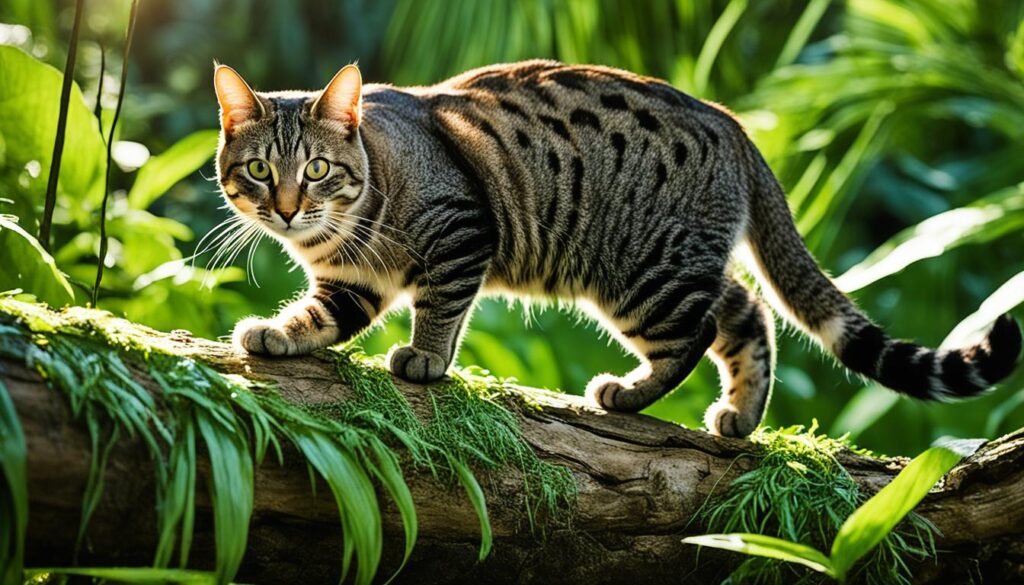
The contrasting habitat preferences of cats and snakes can influence the likelihood of a cat vs snake encounter. While snakes may venture closer to human settlements in search of food or shelter, the urban environments heavily dominated by domestic cats may not provide the ideal hunting grounds for snakes.
Furthermore, the habitat differences between cats and snakes affect their adaptability and survival strategies. Domestic cats have adapted to thrive in human-centric environments, leveraging their agility and stealth to secure prey and avoid danger. In contrast, snakes like the African Rock Python have developed specialized hunting techniques and camouflage to navigate through natural habitats.
Considering these habitat disparities, it becomes evident that the environment in which a cat vs snake encounter takes place can tip the scales in favor of one predator over the other. The adaptability and survival skills of snakes face off against the agility and hunting prowess of cats, creating a captivating dynamic in the wild.
| Cats | Snakes |
|---|---|
| Prefer human settlements and domesticated environments | Thrive in various habitats, from dense forests to urban areas |
| Coexist with humans and adapt to urban landscapes | Exhibit adaptability and survival skills in natural environments |
| Rely on agility and stealth in hunting | Utilize specialized hunting techniques and camouflage to secure prey |
Natural Instincts and Behaviors
Understanding the natural instincts and behaviors of cats and snakes can provide insightful knowledge into their potential interactions. Cats, known for their agility and hunting prowess, possess sharp claws and teeth that serve as formidable weapons for hunting and defense. These natural tools enable them to efficiently catch prey and protect themselves from potential threats. On the other hand, snakes rely on their powerful bodies, fangs, and constriction techniques to capture and subdue their prey.
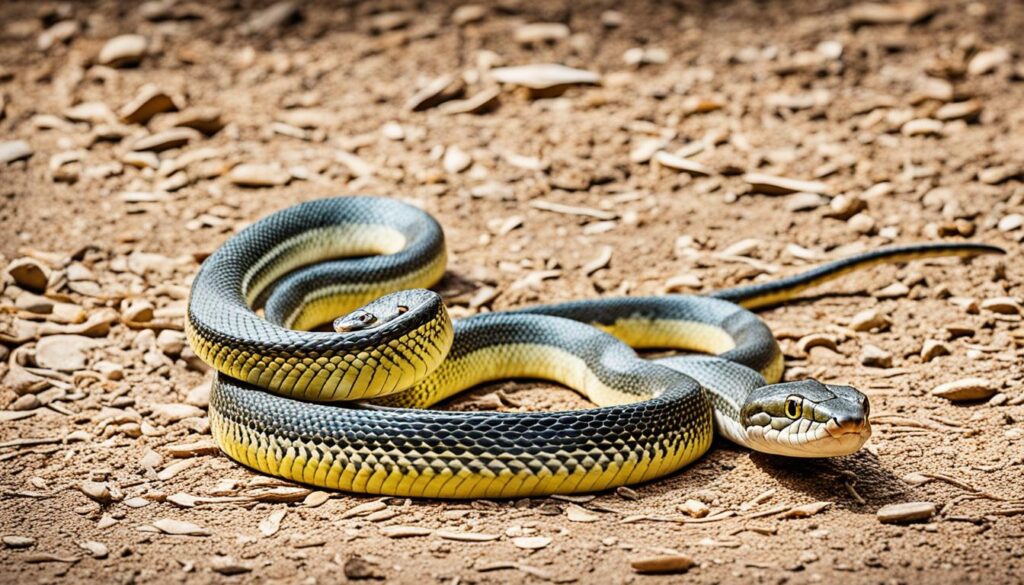
When engaging in a confrontation, cats instinctively use their claws and teeth to scratch, bite, and overpower their opponents. They employ quick, calculated movements to outmaneuver their adversaries, utilizing their agility and speed to their advantage. Snakes, however, employ a different strategy. With their muscular bodies and unique hunting techniques, they can constrict and suffocate their prey or inject venom with precision. These natural instincts and behaviors shape the strategies and tactics each predator employs in a confrontational situation.
“Cats possess sharp claws and teeth, which they use for hunting and defense.”
“Snakes rely on their powerful bodies, fangs, and constriction techniques to capture and subdue their prey.”
An Assessment of Strengths and Weaknesses
Conducting an assessment of the strengths and weaknesses of cats and snakes is crucial in determining the outcome of a tussle. Cats possess agility, speed, and sharp senses, which enable them to be effective hunters. Snakes, on the other hand, have powerful bodies, venomous or constricting capabilities, and the ability to ambush their prey. Evaluating these strengths and weaknesses can provide insights into each predator’s advantage in a confrontation.
Let’s take a closer look at the strengths of cats in a cat vs snake showdown:
- Agility: Cats are incredibly agile, able to leap, pounce, and change direction swiftly. This gives them an advantage in evading a snake’s strike.
- Speed: Cats are known for their speed, allowing them to quickly close in on their target or escape from danger.
- Sharp Senses: Cats possess keen senses, including exceptional hearing, night vision, and the ability to detect subtle movements. These senses help them locate potential threats and prey.
While cats have their strengths, snakes have their own set of advantages:
- Powerful Bodies: Snakes have muscular bodies that allow them to constrict their prey, immobilizing them and preventing escape.
- Venomous or Constricting Capabilities: Certain snake species possess venomous bites that can incapacitate their prey. Others rely on constriction to subdue their victims.
- Ambush Tactics: Snakes are masters of camouflage and patience, often lying in wait for unsuspecting prey to pass by. This method allows them to surprise and seize their targets effectively.
Understanding these strengths and weaknesses helps us evaluate the potential outcomes of a cat vs snake encounter. While cats possess agility and speed to evade a snake’s strike, snakes have powerful bodies and predatory techniques that give them a distinct advantage. The dynamics of a cat vs snake encounter will largely depend on the specific circumstances, size differential between the two predators, and individual strategies employed.
| Cats | Snakes |
|---|---|
| Agility | Powerful Bodies |
| Speed | Venomous or Constricting Capabilities |
| Sharp Senses | Ambush Tactics |
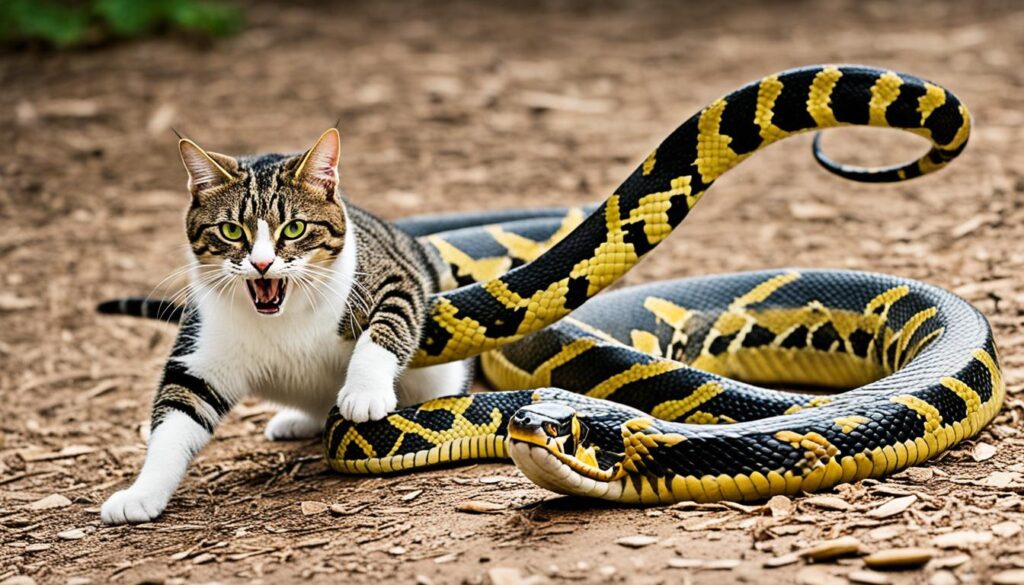
Case Studies and Observations
Examining real-life case studies and observations of cat vs snake interactions provides valuable insights into the potential outcomes of these encounters. While direct confrontations between cats and snakes may be relatively rare, documented instances of cats defending themselves against snakes, or vice versa, offer a glimpse into the strategies and tactics employed by each predator. Through these observations, we can gain a deeper understanding of the intricate dynamics that exist between these two species in the natural world.
“In one notable case study, a homeowner captured a video of their cat successfully fending off a snake that had entered their property. The cat showcased remarkable agility and quick reflexes, lunging at the snake and forcing it to retreat.”
Observations of cat vs snake interactions in the wild have also shed light on the potential outcomes of these encounters. Researchers have documented instances where cats have been seen stalking and pouncing on snakes, utilizing their natural hunting instincts to overpower their slithery adversaries. Conversely, snakes have demonstrated their prowess by successfully capturing and constricting cats, using their unique physical attributes and hunting techniques to secure their prey.
These case studies and observations allow us to delve deeper into the fascinating dynamics between cats and snakes. By analyzing the strategies employed by each predator, we can gain valuable insights into their strengths, weaknesses, and potential outcomes in a tussle. Let’s explore some notable case studies and observations that highlight the complex interplay between these two formidable opponents.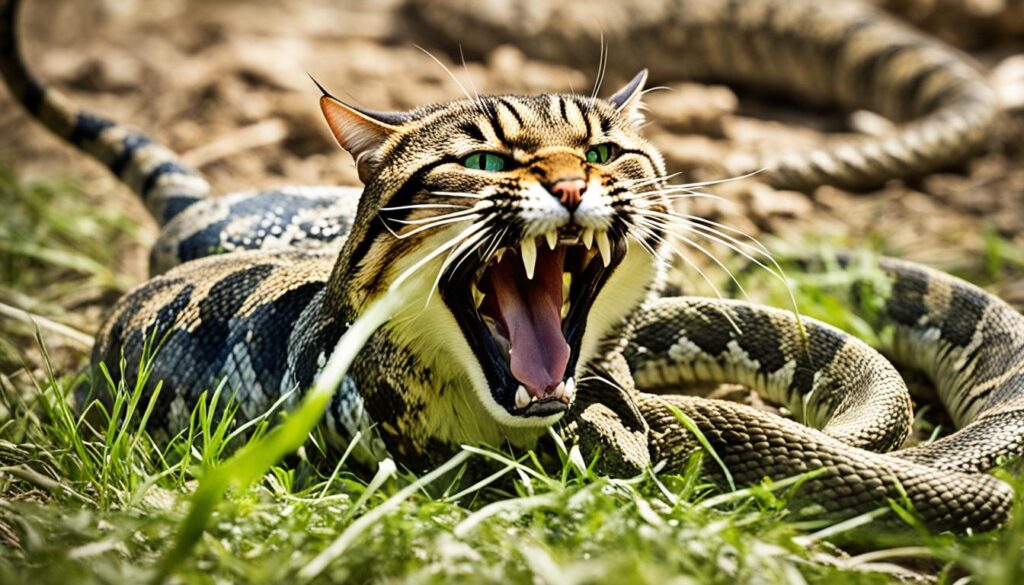
A Notable Case Study: Cat vs Eastern Brown Snake
In a documented case study conducted in Australia, a domestic cat encountered an Eastern Brown Snake, known for its highly venomous bite. The cat’s natural instincts kicked in, and it engaged in a mesmerizing dance of caution, circling the snake while keeping a safe distance. With lightning-fast reflexes and razor-sharp claws, the cat managed to deliver a series of precise strikes, leaving the snake injured and ultimately forcing it to retreat. This case study showcases the incredible defensive capabilities of cats when faced with formidable opponents.
Observational Insights: Cat vs Python
Observations in African ecosystems have revealed intriguing interactions between domestic cats and pythons. While pythons pose a significant threat to cats due to their size and constricting abilities, cats have been observed employing stealth and agility to avoid direct confrontations. By staying alert and utilizing their quick reflexes, cats are often able to outmaneuver pythons and evade their deadly grasp. These observations highlight the importance of strategy and adaptability in cat vs snake interactions.
Strategies of Survival: Snake Avoidance Conditioning
Snake avoidance conditioning is a behavioral training technique used to teach dogs to avoid encounters with venomous snakes. Interestingly, these training sessions often involve using non-venomous snakes to simulate encounters. This technique showcases the instinctive aversion that many animals, including cats, develop towards snakes. By associating the sight, sound, and smell of snakes with negative experiences, trainers can help these animals learn to avoid potentially dangerous encounters.
These case studies and observations provide valuable glimpses into the complex world of cat vs snake interactions. While each situation is unique and the outcome may vary, understanding these dynamics enhances our appreciation for the diverse strategies employed by these remarkable predators in their age-old rivalry.
The Complexity of Wildlife Interactions
In the world of wildlife, interactions between different species are intricate and multifaceted. When it comes to the cat vs snake dynamic, the outcome of an encounter cannot be easily predicted. Numerous factors contribute to the potential triumph or failure of either predator in a tussle.
Size plays a crucial role in determining the power balance between cats and snakes. The contrast in their physical characteristics, with snakes often surpassing cats in length and weight, presents an interesting dynamic.
Habitat and environment also influence the course of cat vs snake interactions. The adaptability of snakes across various landscapes in contrast to the more domesticated nature of cats creates further complexity in assessing their encounters.
The instincts and behaviors unique to each predator add another layer of complexity. Cats possess sharp claws and teeth, while snakes rely on their powerful bodies and venomous or constriction abilities.Appreciating the complexity of wildlife interactions allows us to delve deeper into the nuances of cat vs snake encounters.
To provide a comprehensive understanding of these interactions, let’s explore some of the key factors and examples:
Factors that Influence Cat vs Snake Wildlife Interactions
1. Size and physical characteristics
2. Habitat and environment
3. Dietary preferences
4. Predator-prey dynamics
5. Natural instincts and behaviors
Examples of Cat vs Snake Wildlife Interactions
- A documented case of a domestic cat successfully fending off an African Rock Python
- An observation of a python ambushing and capturing a small rodent, evading a cat’s predatory attempts
- A scenario where a cat and a snake coexist peacefully within the same environment without direct confrontations
Exploring the complexities of cat vs snake interactions allows us to appreciate the diverse strategies and adaptations exhibited by these predators. Understanding the nuances of their encounters brings us closer to the intricate dynamics of the natural world.
| Factors | Cats | Snakes |
|---|---|---|
| Size | Smaller and lighter | Longer and heavier |
| Habitat | Domesticated environments | Diverse landscapes |
| Dietary Preferences | Carnivores, prey on smaller animals | Primarily prey on small to medium-sized mammals |
| Predator-Prey Dynamics | Generally avoid confronting larger or similarly sized animals | Prey on species smaller than themselves |
| Natural Instincts | Sharp claws and teeth | Powerful bodies, fangs, and constriction techniques |
Conclusion
In the battle between cats and snakes, the outcome is far from predictable. Size, diet, environment, and predator-prey dynamics all play a role in determining which predator may come out on top. While there may be cases where a cat successfully defends itself against a snake or vice versa, it is essential to recognize and appreciate the unique characteristics and adaptations of each predator.
The complexities of cat vs snake interactions provide us with a deeper understanding of the natural world and the diverse strategies employed by different species. It is through studying these encounters that we gain insights into the intricacies of wildlife dynamics and the delicate balance that exists among predators and their prey.
By delving into the nuances of cat vs snake encounters, we can broaden our appreciation for the beauty and complexity of nature. From the agility and speed of cats to the strength and specialized hunting techniques of snakes, each predator showcases its unique set of skills. When observing wildlife, it is important to remember that these interactions are not isolated incidents but rather essential components of the intricate web of life.FAQ
Who would win in a fight between a cat and a snake?
What are the physical characteristics of cats and snakes?
What do cats and snakes typically eat?
How do predator-prey dynamics affect cat vs snake interactions?
Are there any recorded instances of cat vs snake encounters?
How does the environment and habitat impact cat vs snake encounters?
What are the natural instincts and behaviors of cats and snakes?
What are the strengths and weaknesses of cats and snakes?
Are there any case studies or observations of cat vs snake interactions?
How complex are wildlife interactions between cats and snakes?
As our Editor-in-Chief, James plays a pivotal role in ensuring the quality and integrity of our content. With a keen eye for detail and a passion for storytelling, James oversees the editorial process here at A Place for Animals. With years of experience in content editing, James ensures that every piece of content meets our high standards of accuracy and clarity. Under James’ guidance, you can rest assured that the content you read is informative and impeccably crafted.
Hamsters
Can Hamsters Eat Cilantro? Pet Nutrition Tips
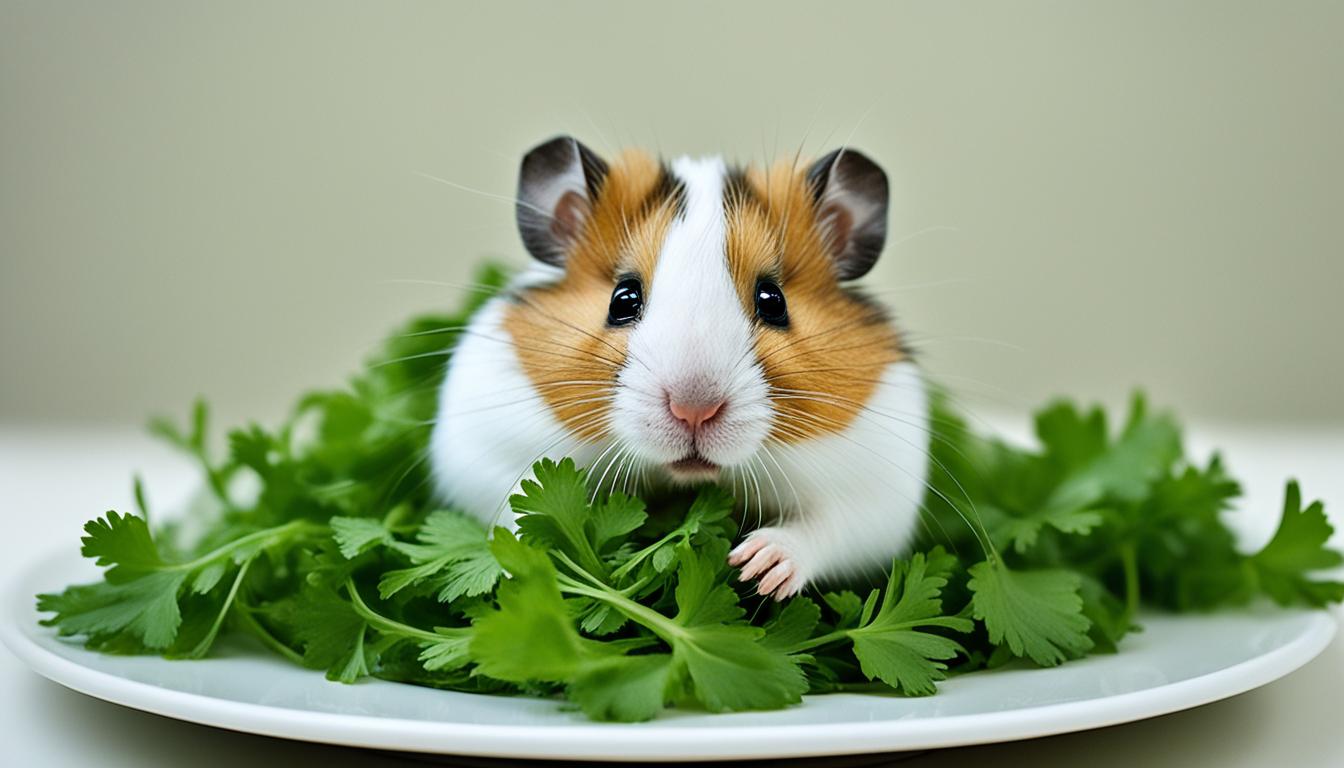
Are you aware of the fact that hamsters have specific dietary requirements that can significantly affect their health and overall well-being? While many believe that these tiny creatures only require commercial pellet food, they can also enjoy a variety of fresh foods in moderation. Cilantro, a popular herb in numerous cuisines, is one example. But is it safe for hamsters to consume cilantro? Let’s delve into the nutritional advantages and feeding recommendations for giving cilantro to your furry companion.
Key Takeaways:
- Hamsters can eat cilantro occasionally, but it should be served as a treat or supplement to their regular diet.
- Cilantro, along with other safe fruits and vegetables, can provide variety and additional nutrients for your hamster.
- Most of your hamster’s diet should consist of a commercial pellet food formulated for hamsters.
- It’s important to consult with a veterinarian for personalized advice on your hamster’s nutrition.
- Offer a balanced diet and ensure your hamster’s portions are appropriate to prevent weight gain.
Including Cilantro in Your Hamster’s Diet
When it comes to creating a healthy and well-balanced diet for your hamster, including cilantro can add variety and essential nutrients to their meals. However, it’s important to remember that cilantro and other safe fruits and vegetables should be considered as additions to your hamster’s diet rather than staple foods.
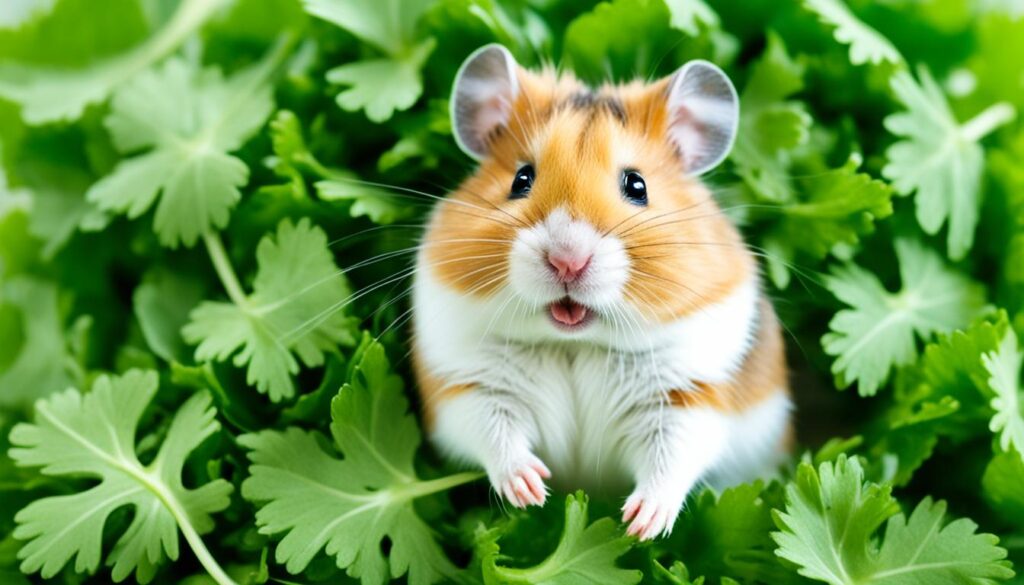
As with any fresh food, the key is moderation. You can rotate the fresh foods you offer to your hamster each day, introducing new flavors and textures. This not only adds excitement to their meals but also ensures they receive a diverse range of nutrients. However, keep the portions small to maintain a balanced diet for your hamster.
“Including cilantro in your hamster’s diet can provide enrichment and stimulate their natural foraging instincts.”
Offering fresh cilantro and other fruits and vegetables as treats can provide enrichment and stimulate your hamster’s natural foraging instincts. It’s important to keep an eye on their preferences and adjust accordingly. Remember, every hamster is unique, so it may take some trial and error to figure out which fresh foods they enjoy the most.
Balancing Your Hamster’s Diet
While it’s exciting to incorporate fresh foods like cilantro, it’s crucial to ensure that the majority of your hamster’s diet consists of a commercial pellet food formulated specifically for hamsters. These pellets are specially balanced to provide your little friend with all the necessary nutrients they need for optimal health.
Here is a simple guide to balancing your hamster’s diet:
- Commercial pellet food: Feed your hamster about 1/8-1/3 cups of pellets daily, depending on their size and appetite. This should be the main component of their diet.
- Cilantro and other fresh foods: Offer small portions of fresh cilantro and other safe fruits and vegetables as treats. Remember to remove any uneaten fresh food to prevent spoiling.
- Timothy hay: Provide Timothy hay as a source of dietary fiber and enrichment. Your hamster will enjoy nibbling on the hay, and it also aids in maintaining healthy digestion.
By following this balanced approach, you can ensure that your hamster receives a well-rounded diet that meets their nutritional needs. Remember to consult with a veterinarian if you have any concerns about your hamster’s nutrition or if you’re unsure about which fresh foods are safe to include in their diet.
How to Feed Cilantro to Your Hamster
When it comes to adding fresh cilantro to your hamster’s diet, it’s important to do so in a safe and controlled manner. Here are some steps to follow:
1. Wash Fresh Cilantro Thoroughly
Before feeding cilantro to your hamster, make sure to wash it thoroughly to remove any dirt or chemicals. This step is crucial to ensure your hamster’s safety and well-being.
2. Offer a Small Amount as a Treat
Cilantro should be offered to your hamster as a treat, not as a staple food. It should be given in small quantities to prevent overconsumption and to maintain a balanced diet. Remember, moderation is key.
3. Combine Cilantro with Other Fruits and Vegetables
You can mix fresh cilantro with other safe fruits and vegetables to provide a variety of flavors and nutrients. Just like humans, hamsters enjoy a diverse diet. Offer a small portion of cilantro alongside other fresh foods.
4. Remove Uneaten Cilantro Daily
It is important to remove any uneaten cilantro and other fresh food from your hamster’s enclosure each day. Leaving food out for too long can lead to spoilage and potential health issues. By removing uneaten food, you ensure that your hamster’s environment remains clean and hygienic.
| Steps to Feed Cilantro to Your Hamster |
|---|
| Step 1: Wash fresh cilantro thoroughly |
| Step 2: Offer a small amount as a treat |
| Step 3: Combine cilantro with other fruits and vegetables |
| Step 4: Remove uneaten cilantro daily |
By following these steps, you can safely add cilantro to your hamster’s diet as an occasional treat. Remember to always prioritize a commercial pellet food as the main source of nutrition for your furry friend. Consult with a veterinarian for personalized advice on your hamster’s specific dietary needs.
What Should Your Hamster’s Main Food Source Be?
When it comes to your hamster’s nutrition, commercial pellet food should be the main focus of their diet. These specially formulated pellets provide the essential nutrients that your hamster needs to thrive. Along with pellet food, Timothy hay is a crucial component of your hamster’s diet, serving as both a source of bedding and dietary fiber.
While there are various options available in the market, it’s important to choose a high-quality pellet food that is specifically designed for hamsters. Avoid formulas that primarily consist of seeds, nuts, and dried fruits. These types of food are often higher in sugar and fat, and may not provide the necessary balanced nutrition for your furry friend.
Here are a few key reasons why commercial pellet food should be your hamster’s main food source:
- Nutritional Balance: Commercial pellet food is formulated to meet the nutritional needs of hamsters. It contains a balanced combination of proteins, carbohydrates, fats, vitamins, and minerals.
- Convenience: Pellet food is easy to store, measure, and feed. It eliminates the hassle of finding, preparing, and portioning out various ingredients for your hamster’s meals.
- Digestive Health: The composition of pellet food ensures proper digestion for your hamster. It helps maintain their overall digestive health and prevents issues such as diarrhea or constipation.
While commercial pellet food should make up the majority of your hamster’s diet, it’s important to regularly supplement their meals with approved fresh foods, such as small amounts of fruits and vegetables. This helps provide additional nutrients, variety, and enrichment to their diet.
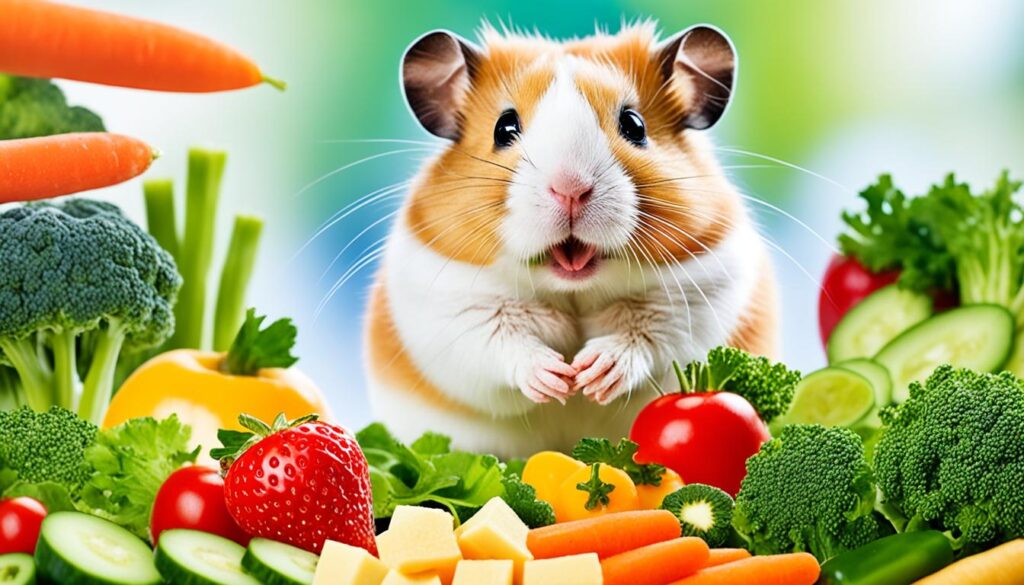
Which Fruits and Vegetables Can Hamsters Eat?
When it comes to incorporating fruits and vegetables into your hamster’s diet, there are plenty of options to choose from. Most vegetables and fruits are safe for hamsters to consume in moderation, providing them with essential nutrients and variety in their meals.
However, it’s important to be aware of certain fruits and vegetables that should be avoided. Citrus fruits like oranges or grapefruit can be too acidic for hamsters’ delicate digestive systems, so it’s best to steer clear of them. Additionally, dried fruits or vegetables should also be avoided as they often contain high levels of sugar that can be harmful to your furry friend’s health.
Here are some safe and nutritious fruits and vegetables that you can include in your hamster’s diet:
- Leafy greens: Spinach, kale, and lettuce provide essential vitamins and minerals.
- Root vegetables: Carrots and radishes are crunchy treats that hamsters enjoy.
- Berries: Strawberries, blueberries, and raspberries are packed with antioxidants.
- Squash: Zucchini and butternut squash are tasty options for your hamster.
- Cucumbers: These refreshing vegetables help keep your hamster hydrated.
- Apple slices: Remove the core and seeds, and offer your hamster small apple slices as a treat.
Remember to introduce new foods gradually to monitor your hamster’s reaction and prevent any digestive issues. Offering a varied diet of safe fruits and vegetables alongside a balanced commercial pellet food will help ensure your hamster’s overall well-being.
“Including a variety of fruits and vegetables in your hamster’s diet not only provides essential nutrients but also adds interest and stimulation to their meals.”
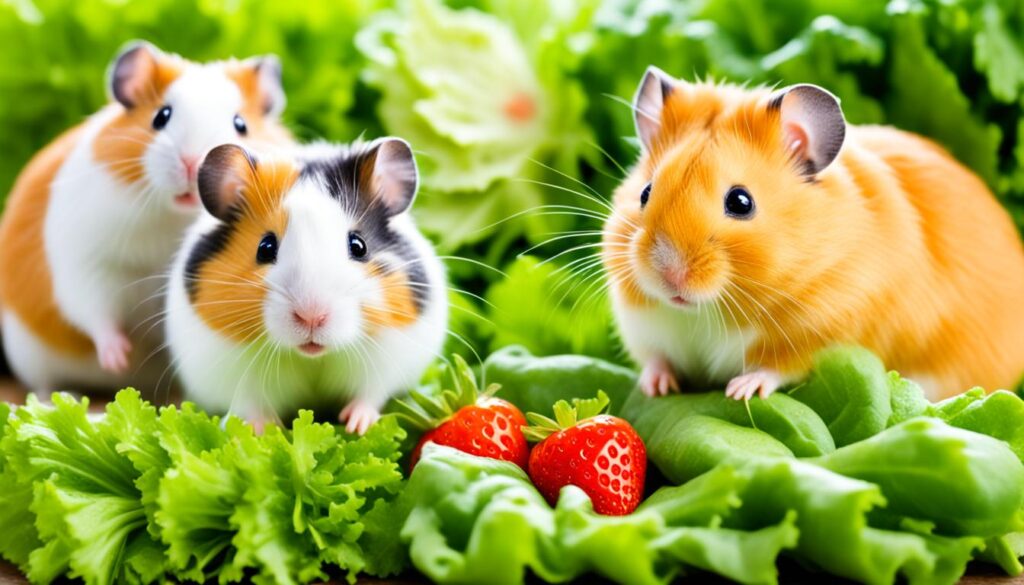
Safe Fruits and Vegetables for Hamsters
| Fruits | Vegetables |
|---|---|
| Strawberries | Spinach |
| Blueberries | Kale |
| Raspberries | Lettuce |
| Apple slices | Carrots |
| – | Radishes |
| – | Zucchini |
What Other Foods Can Hamsters Eat?
Hamsters are omnivores, which means they can eat a variety of foods, including some animal protein. Incorporating protein-rich foods into your hamster’s diet can provide them with essential nutrients and added variety. Here are some options:
- Hard-Boiled or Plain Scrambled Eggs: Eggs are a great source of protein for hamsters. You can offer small pieces of hard-boiled eggs or plain scrambled eggs as an occasional treat. Make sure to remove any uneaten portions to prevent spoilage.
- Mealworms: Mealworms are another protein-rich option that hamsters enjoy. These small worms can be offered as a treat or added to their regular food. Ensure they are from a reputable source and provide them in moderation.
- Whole Grain Crackers: For a crunchy snack, you can offer your hamster some whole grain crackers. Look for options that have minimal added sugars and salts. Break the crackers into small pieces suitable for your hamster’s size.
- Sugarless Cereal: Some sugarless cereals can be a fun and occasional treat for your hamster. Look for options with whole grains and no added sugars. Offer small amounts and monitor their reaction to ensure they tolerate the cereal well.
Remember, these additional foods should be offered in moderation and as treats, rather than the main part of your hamster’s diet. Always observe your hamster’s preferences and digestive tolerance when introducing new foods.

How Much Should Hamsters Eat?
When it comes to feeding hamsters, it’s important to strike the right balance. Providing them with the proper portion size ensures they receive the nutrition they need without overeating. So, how much should hamsters eat?
On average, hamsters should eat about 1/8-1/3 cups of pellets daily, supplemented with fresh food. However, it’s essential to note that the portion size may vary depending on factors such as the hamster’s age, breed, and size. For accurate and personalized recommendations, consulting with a veterinarian is the best approach.
Feeding hamsters too much can lead to weight gain and associated health issues. That’s why it’s crucial to calculate their ideal daily calorie intake to avoid overfeeding. By providing the right portion size, you can help keep your hamster happy, healthy, and in great shape.
Creating a Nutritious Hamster Diet:
It’s important to remember that the portion size mentioned above includes both pellets and fresh food. To ensure a well-rounded and enjoyable diet for your furry friend, consider the following:
- Commercial pellets: These should form the main part of your hamster’s diet. Choose a high-quality pellet food specifically formulated for hamsters.
- Fresh food: Offer a variety of fresh fruits, vegetables, and occasional treats in small quantities. This provides additional nutrients and mental enrichment for your hamster.
Here’s a table summarizing the portion sizes:
| Food Type | Portion Size |
|---|---|
| Pellets | 1/8-1/3 cups per day |
| Fresh food | Small quantities as treats |

“Proper portion size is key to a healthy hamster diet. Providing a balanced combination of pellets and fresh food ensures your hamster receives the necessary nutrients without overindulging.”
To further guide you in creating a nutritious hamster diet, here are some additional tips:
- Rotate the types of fresh foods you offer to provide variety and prevent boredom.
- Wash fresh fruits and vegetables thoroughly before feeding them.
- Remove any uneaten fresh food daily to prevent spoilage.
By carefully monitoring portion sizes and offering a well-balanced diet, you can keep your hamster happy, healthy, and thriving.
When Should You Feed Your Hamster?
Hamsters are nocturnal creatures, which means they are most active at night. Because of their natural inclination, they may prefer to eat during the nighttime hours. However, when it comes to feeding your hamster, there is some flexibility in timing.
When it comes to pellets, you can provide them at any time of day. This ensures that your hamster has constant access to their main source of nutrition. However, when it comes to offering fresh food like cilantro, it is recommended to do so in the evening. By providing fresh food during the evening hours, your hamster will have the opportunity to enjoy it during their active period.
If your hamster does not consume all the fresh food you provide, make sure to remove any uneaten portions in the morning. This prevents the food from spoiling and keeps your hamster’s cage clean and hygienic.
“Feeding fresh food like cilantro in the evening allows your hamster to enjoy it during their active period.”
It’s important to note that every hamster has different preferences and habits. If you consistently find that your hamster leaves fresh food uneaten, it may be worth reducing the portion size. Adjusting the amount of fresh food based on your hamster’s eating habits ensures they receive the right amount of nutrition without wasting food.
Creating a feeding schedule that aligns with your hamster’s natural behavior can help promote a healthy relationship with food. By understanding their nocturnal nature and adjusting feeding times accordingly, you can ensure your hamster has access to fresh food during their active hours.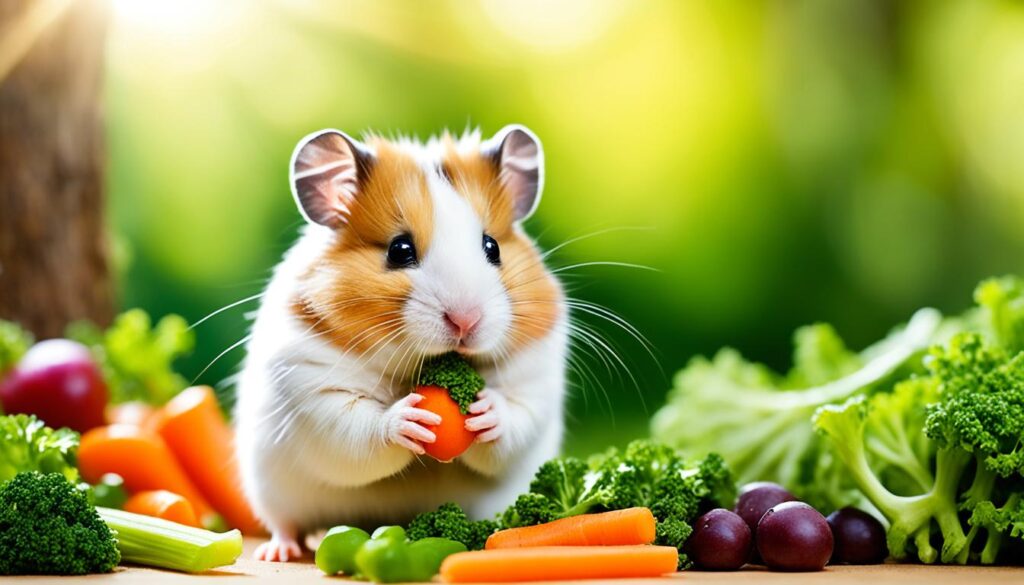
Conclusion
After careful consideration, we can confidently say that hamsters can enjoy cilantro as part of their diet. However, it’s crucial to remember that cilantro should only be given as an occasional treat or supplement to their regular food.
To ensure proper nutrition for your furry friend, the main source of their diet should be a high-quality, commercial pellet food specifically formulated for hamsters. These pellets contain the essential nutrients and vitamins that hamsters need to thrive.
That being said, fresh fruits and vegetables, including cilantro, can be offered in small quantities to provide variety and additional nutrients. Just remember to wash the cilantro thoroughly before serving it to your hamster, and remove any uneaten fresh food daily to prevent spoilage.
If you have any concerns or questions about your hamster’s nutrition, it’s always a good idea to consult with a veterinarian. They can provide personalized advice based on your hamster’s specific needs, ensuring that they receive the best possible care and diet.FAQ
Can hamsters eat cilantro?
How should I include cilantro in my hamster’s diet?
How should I feed cilantro to my hamster?
What should be the main food source for my hamster?
Which fruits and vegetables can hamsters eat?
What other foods can hamsters eat?
How much should hamsters eat?
When should I feed my hamster?
Can I feed my hamster cilantro as their main food?
As our Editor-in-Chief, James plays a pivotal role in ensuring the quality and integrity of our content. With a keen eye for detail and a passion for storytelling, James oversees the editorial process here at A Place for Animals. With years of experience in content editing, James ensures that every piece of content meets our high standards of accuracy and clarity. Under James’ guidance, you can rest assured that the content you read is informative and impeccably crafted.
-

 Vetted2 months ago
Vetted2 months ago15 Best Cat Foods for Managing Hyperthyroidism – Vet Approved and Feline Friendly
-

 Vetted2 months ago
Vetted2 months ago15 Best Dog Foods for Kidney Disease – Expert Recommendations for Your Pet's Health
-

 Animal Facts2 months ago
Animal Facts2 months agoSpring Animals: A Guide to Seasonal Wildlife
-

 Cats1 day ago
Cats1 day agoTop 5 Cat Breeders in Arkansas: A Guide
-

 Vetted2 months ago
Vetted2 months ago15 Best Fresh Dog Food Delivery Services for Your Pup's Health and Happiness
-

 Rabbits2 months ago
Rabbits2 months agoExploring Rabbit Holes: What Do They Look Like?
-

 Pets2 months ago
Pets2 months agoLatest Pet Statistics in US – Trends & Insights in 2024
-
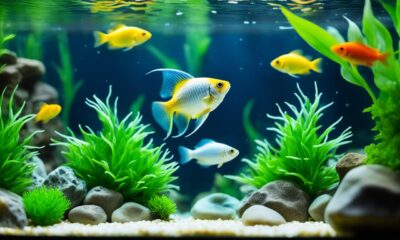
 Fish2 months ago
Fish2 months agoKeeping Your Sucker Fish Thriving at Home




















